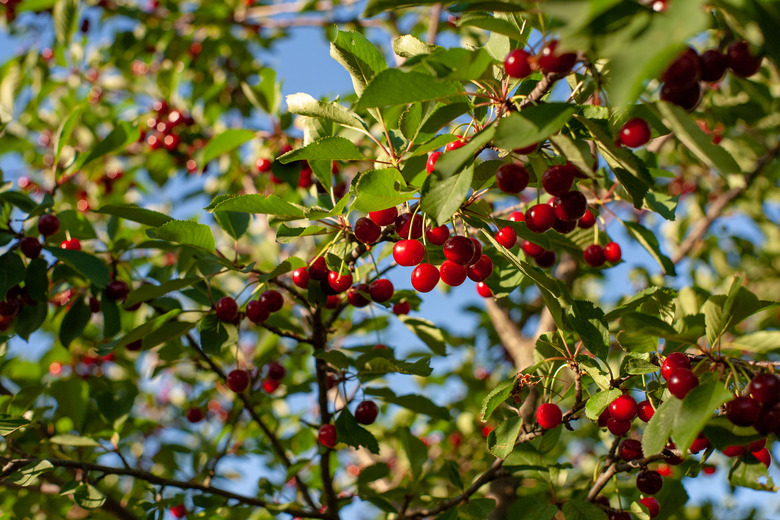How To Start Cherry Trees From Cuttings
We may receive a commission on purchases made from links.
Cloning or propagating plants from cuttings is one method for adding more plants to your garden. Many houseplants are fairly easy to propagate by cuttings, but an experienced gardener can also propagate hardwood trees using this method. The sweet cherry tree (Prunus avium) is one hardwood tree that can be started from cuttings as long as you follow the correct procedure. It's important to know that grafting is the preferred propagation method for cherry trees, and only skilled gardeners and horticulturists have mastered this process.
Growing cherry trees from cuttings can be more difficult than starting a plant from a cherry seed. Nonetheless, propagation from cuttings is possible and can give you a head start on the growing process. Cherry trees grow best in U.S. Department of Agriculture plant hardiness zones 3 to 8..
Take a Cherry Tree Cutting
Take a Cherry Tree Cutting
The procedure for cloning of a cherry tree depends on whether you opt for a softwood, semi-hardwood or hardwood cutting. Taking the right cuttings at the right time is key to successful cherry tree propagation. Softwood cuttings are taken from the tender new growth of your tree in May, June or July. These cuttings should have leaves at different stages of development and should spring back when bent. Semi-hardwood cuttings are taken later in the year, from about mid-July to early fall. This wood is firmer than that of softwood cuttings and bears full-size leaves. Hardwood cuttings snap easily when bent, and they're best taken during a tree's dormant period. Aim for cuttings between 6 to 12 inches long.
- Using clean, sharp hand shears, cut the stems at a slight angle.
- Carefully remove any leaves, buds, or fruit from the bottom half of the cuttings using the shears.
- Keep the cuttings moist during the transplanting process because if they dry out, they're more likely to die.
Plant a Cherry Tree Cutting
Plant a Cherry Tree Cutting
Moist soil and excellent drainage are important when trying to root cuttings, so use a reasonably shallow pot with drainage holes in the bottom. A mixture of equal parts coarse sand, perlite, and Sphagnum peat moss or coconut coir can also boost drainage.
- Water the mixture of sand, perlite, and peat moss or coconut coir thoroughly before planting your cuttings, leaving it adequate time to drain.
- You can then press your cuttings into the mix, taking care to insert them with the cut ends down.
- Use a pencil to make small holes in the rooting medium at least 2 inches apart.
- Apply rooting powder to the cut ends can help your cuttings to grow roots. Apply it to the bottom third of each cutting if you choose to use it and tap the cutting prior to planting to remove loose rooting powder.
- Place your cuttings in the holes to about one-third to one-half of their length and gently firm the rooting medium around them.
During the warm seasons, keep your softwood and semi-hardwood cuttings out of direct sun and maintain even moisture in the rooting mix. During the cooler months, keep your hardwood cuttings at a lower temperature in an unheated porch or garage, but avoid letting them freeze. Excess warmth may encourage the cuttings to sprout too early, but at this point, the focus is on producing roots, not foliage.
Cherry Tree Cutting Care
Cherry Tree Cutting Care
Keeping your cuttings moist is crucial. You don't want your rooting mix to get too soggy or waterlogged, though, so checking the drainage is also important. Spraying your cuttings can help keep the moisture level topped up without adding too much water and risking rot. To maintain high humidity levels, you can also cover your cuttings' pot with a clear plastic bag propped up with stakes or dowels to prevent the plastic from touching the cuttings. If the cuttings are sharing a larger container, you can use clear plastic sheeting over a wire frame instead.
Resist the urge to tug on your cuttings to see if they've rooted as this can damage the roots. Instead, look for signs of sprouting, which means the cuttings have developed roots.
When you're able to see roots growing from the drainage holes of your pot, you can transfer the cuttings to individual pots, taking care to plant them at the same depth at which they were growing in the original pot. If you live within the cherry tree's hardiness zone range, you can also move your cuttings outdoors at this stage. But continue shielding them from extreme temperatures for a minimum of one year before planting them in their permanent locations.
